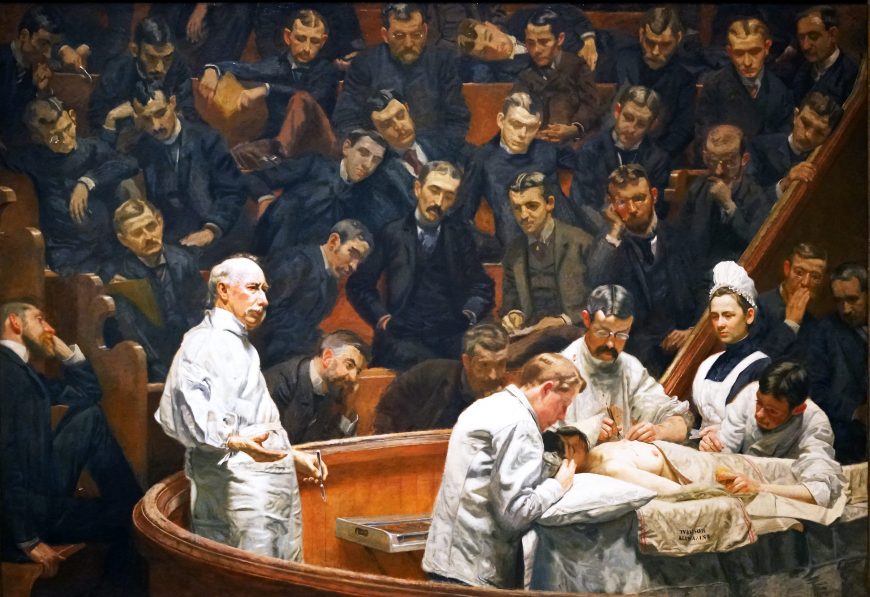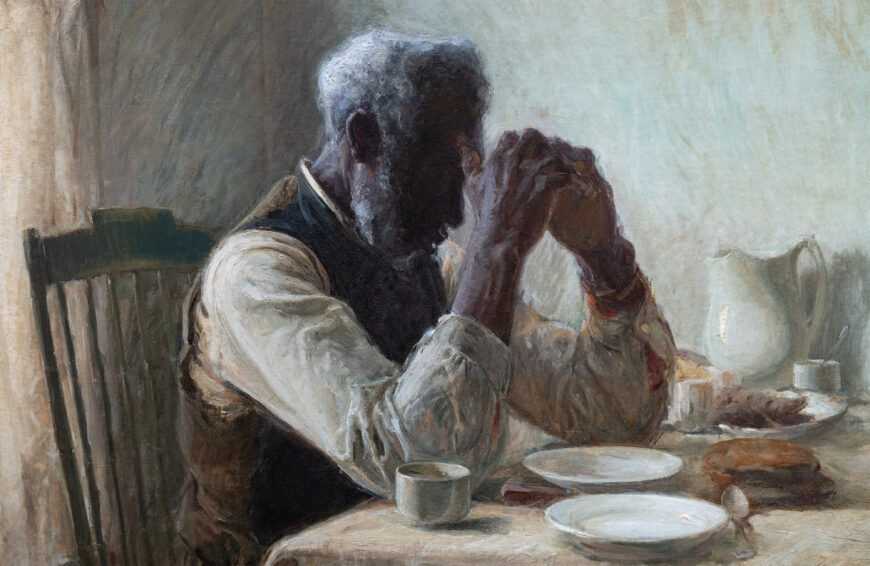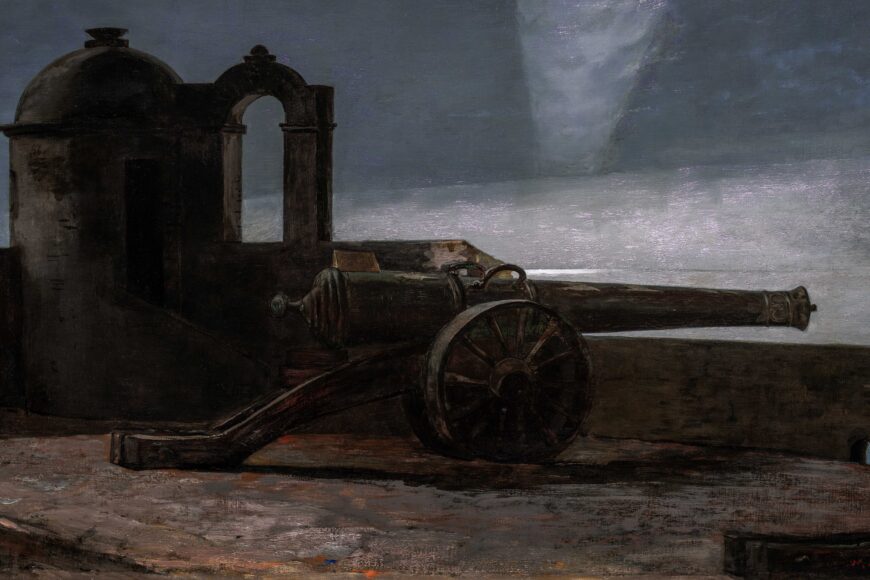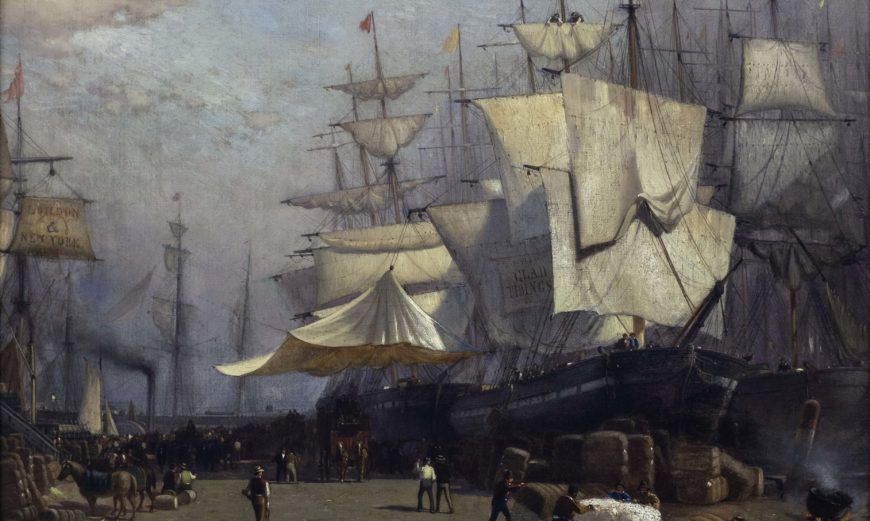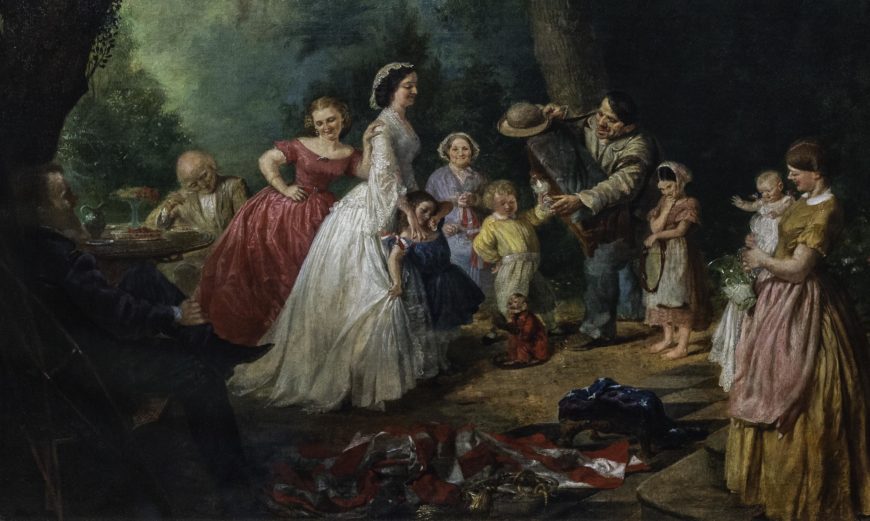Thomas Eakins, Portrait of Dr. Samuel D. Gross (The Gross Clinic), 1875, oil on canvas, 243.8 x 198.1 cm (Philadelphia Museum of Art) and Thomas Eakins, The Agnew Clinic, 1889, oil on canvas, 214 cm × 300 cm (Philadelphia Museum of Art). Speakers: Dr. Kathleen A Foster and Dr. Beth Harris
[0:00] [music]
Dr. Beth Harris: [0:06] We’re in the Philadelphia Museum of Art, looking at two of the most famous paintings by the great American artist Thomas Eakins, both about surgery and two great Philadelphians who took part in that remarkable history.
[0:20] Let’s start with the earlier of the two paintings. This is called “The Gross Clinic.” Not because anything that’s happening in it is gross or disgusting, although some people at the time felt that way, but because we’re looking at a great surgeon, Dr. Gross, and his clinic, a medical class at Jefferson Medical College here in Philadelphia.
Dr. Kathleen A. Foster: [0:40] Dr. Samuel Gross was the most famous surgeon in the world. He was an innovator in surgical techniques. He had written a major textbook.
Dr. Harris: [0:46] He even wrote a handbook for doctors who were treating soldiers during the Civil War.
Dr. Foster: [0:52] Eakins had attended these classes that you see in the Gross clinic. He wanted to make basically a giant poster advertising the excellence of Philadelphia’s medical community to show in the art exhibition at the World’s Fair.
Dr. Harris: [1:05] This was a centennial exhibition celebrating the 100th anniversary in 1876 of the United States. The theme was progress.
Dr. Foster: [1:13] He picked Dr. Gross because he was an innovator in surgical techniques.
Dr. Harris: [1:17] It took me a while to understand even what part of the body I was looking at.
Dr. Foster: [1:22] There’s a little boy who’s lying on his side on the surgical table. His head is far away from you, underneath the gauze of the anesthesiologist, and his little feet in gray socks are what’s pointing at you in the foreground. You’re basically looking at his thigh.
Dr. Harris: [1:36] Also his buttocks. And there are a lot of things that actually didn’t seem polite to many people at the Centennial Exhibition.
Dr. Foster: [1:43] Surgery was something that happened at home. Hospitals were for poor people and full of infection.
Dr. Harris: [1:48] But surgery is becoming something that heals you.
Dr. Foster: [1:51] Science was galloping forward, and two things are shown in this particular surgery that illustrate that advance. One of them is anesthesia, the fact that you can put the patient to sleep so they don’t scream and flail around.
Dr. Harris: [2:03] Surgery before had to be done quickly.
Dr. Foster: [2:06] The other great advance that Dr. Gross is demonstrating here is his new understanding of the way that bones renew. This little boy in the surgery, 10 years earlier, he would have had his leg amputated because that’s the best they could have done for someone who had had this kind of bone infection.
[2:21] But Dr. Gross and his generation understood that just by cleaning out the bone, it would renew. You could sew the boy up and in a month, he would be off and running. So instead of an almost medieval, brutal, life-threatening surgery, now you have surgical intervention that is minimal and has a happy outcome.
Dr. Harris: [2:38] In the 21st century, we take for granted the progress that was made in the 19th century to get us to where medicine is today.
Dr. Foster: [2:45] However, we can see some old-fashioned things. Notice that Dr. Gross is just wearing a suit, a very snappy outfit with velvet collar. He’s got [a] pocket watch and a beautiful opal stud in his shirt. He’s just walked in off the street. At this moment in 1875, Gross was resisting the newest science taught by Dr. Lister, the idea of the germ theory.
[3:08] We will see that ideas about sterile procedures changed. When Eakins goes to paint “The Agnew Clinic,” he shows the doctors all in whites, in sterile clothing and using surgical instruments that have been sterilized in a bath.
Dr. Harris: [3:23] Here we see the anesthesiologist administering chloroform.
Dr. Foster: [3:27] The science of anesthesia was basically watching the patient breathe and taking a towel that had ether or chloroform on it and bringing it closer or farther away from the patient’s mouth and nose.
Dr. Harris: [3:38] But what this painting is really about is Dr. Gross, and also Eakins as a painter.
Dr. Foster: [3:45] Eakins is so clever in using the light to make Gross seem more godlike. The light came through this skylight, and that’s why you only had surgery at noon, because there was no artificial light in the surgical amphitheater.
[3:58] Eakins chooses to show that, and that’s being a Realist, but he makes it magic. Realism works for him in order to accentuate Dr. Gross’ halo of hair, his bright forehead, so that you have this sense of his intelligence and of his leadership.
Dr. Harris: [4:15] Our eye goes down to that bloody hand.
Dr. Foster: [4:18] It was the blood on the hand that got this picture knocked out of the art exhibition; the jury decided that it was too scary for the public, and so they showed the picture in a medical display.
Dr. Harris: [4:29] The woman who’s seated on the left, who we presume to be the patient’s mother, who’s just in agony over the surgery.
Dr. Foster: [4:35] She’s there to represent us. She’s horrified, and she’s not a professional, so she doesn’t really know what’s going on. She contrasts to the competence of the doctors, the teamwork of medicine that is going to push American culture forward.
Dr. Harris: [4:49] So we’re drawn to Dr. Gross. We look at the man who’s recording the surgery, and then in the shadows, two figures standing in a doorway, and on the far right, seated, the artist himself.
Dr. Foster: [5:00] Eakins puts himself in the painting as a way to establish the credibility of his own witness of this scene.
Dr. Harris: [5:06] Eakins is a man of science, and he studies anatomy at Jefferson Medical College.
Dr. Foster: [5:11] Even as a professor, he encouraged his own students to do dissections. He knew a lot about the human body, and he was deeply interested in anatomy and in science in general.
Dr. Harris: [5:20] Let’s turn to this painting by Eakins of the Agnew Clinic that was made 14 years later. Instead of a vertical image with light flooding down on the heroic figure of the doctor, we have a composition that’s more dispersed.
Dr. Foster: [5:33] Dr. Agnew was to the University of Pennsylvania the same kind of celebrity that Samuel Gross was at Jefferson Medical College.
[5:41] When he retired, his students collected money to make a portrait honoring his accomplishment. It has a very different mood than “The Gross Clinic.” The doctors are now wearing white, respecting sterile procedures. Also, the secret here is that there’s now artificial light in the surgical amphitheater.
[5:57] But the one thing that’s the same is that Eakins himself is over in the corner, watching the surgery in the same position that he appears in “The Gross Clinic.”
Dr. Harris: [6:05] Look at Agnew bathed in light with that white surgical gown on. What’s happened is he’s done the surgery. He’s stepped back. He’s going to allow the other doctors to finish the surgery, and he’s going to lecture and explain what happened and the prognosis for the patient.
[6:22] Here we’re seeing a kind of surgery that was more dangerous, a mastectomy. Doctors were still learning how to best treat breast cancer.
Dr. Foster: [6:30] This is not a happy story. Surgery on cancer was still mysterious. What Dr. Agnew was trying to do is make this woman more comfortable because he knows that his surgery’s not going to cure her.
[6:43] So it’s a darker story, and it remains somewhat confusing as to why Eakins would have told a sad story like this, one of pain, but it may be that he was interested in showing a woman. And [it] certainly increases your sense of compassion, to be able to see the face of the patient.
Dr. Harris: [7:00] We also see the nurse. This is a brand new thing, the School of Nursing. The nurse we see here, Nurse Clymer, was one of the early graduates.
Dr. Foster: [7:08] Nurse Clymer is fun to compare to the mother in “The Gross Clinic.” The mother is hysterical. Nurse Clymer is educated, professional, completely composed. She is making sure that the doctors are using sterile instruments.
Dr. Harris: [7:22] And she’s contrasted with the male students. They look very much the way students look. They lean this way and that. Some of them pay more attention than others.
Dr. Foster: [7:31] The students all came to Eakins’ studio and posed for him, so they were all portraits. I think there was a certain amount of joking going on here as he depicted them in characteristic poses.
Dr. Harris: [7:40] We also see the tray of instruments just in front of Dr. Agnew, in a bath that’s sterilizing them. We’re reminded of this recent invention of sterilizing [the] surgical theater.
Dr. Foster: [7:51] The result is that the scalpel that he’s holding is dripping water, not blood. Dr. Agnew actually asked to be shown without as much blood because he knew that the portrait of Dr. Gross had been very upsetting to many people.
Dr. Harris: [8:03] Although it’s still a difficult image to look at. We can see a surgical implement being inserted into her chest cavity. Eakins wasn’t shy of that. In a way, that was his goal, to paint something heroic about modern life.
[8:18] We didn’t need to paint ancient Greek gods and goddesses or the ancient historical events to paint heroes. We could paint modern heroes. That’s what we get with both Gross and Dr. Agnew.
Dr. Foster: [8:29] Eakins wants to be up there with Rembrandt and Velázquez. He’s intending to make a history painting for the modern age.
[8:36] Both of these paintings show teams at work. That’s actually the way science works, too. The teamwork that you see is exactly what would send men to the moon. He chooses modern science as a noble and important subject for a great modern history painting.
[8:52] [music]
Thomas Eakins’s deep connection to his birthplace remained a theme throughout his career. Perhaps his most well-known and ambitious work for the city of Philadelphia is The Gross Clinic, a painting completed in 1875 that spotlights the local physician Samuel David Gross.

Thomas Eakins, The Gross Clinic, 1875, oil on canvas (Philadelphia Museum of Art & the Pennsylvania Academy of Fine Arts)
Always a portraitist
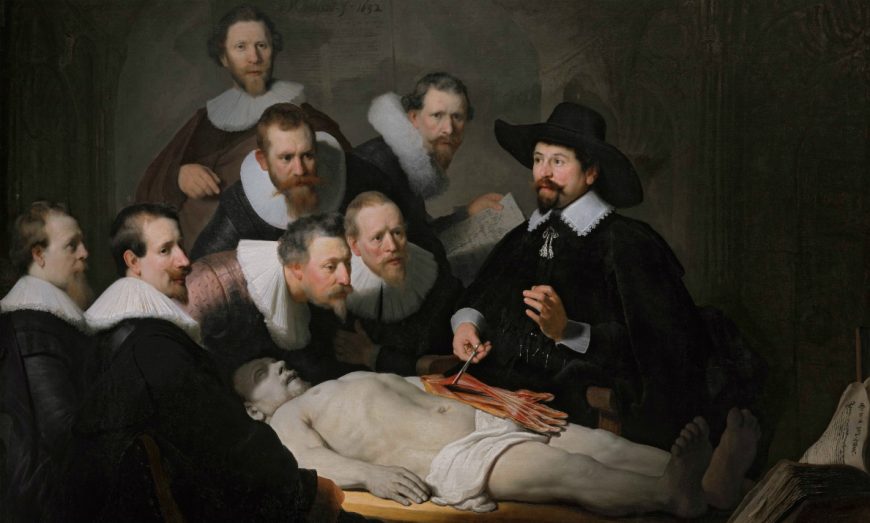
The scene depicts Gross overseeing a surgery and lecturing to a class of medical students—evoking Rembrandt’s art historical precedent The Anatomy Lesson of Dr. Tulp (1632). Much like Rembrandt’s version, The Gross Clinic documents medical sanitary procedures of its time, but the painting’s real focus are living figures. Always a portraitist, Eakins calculated the work as a visual record of all the individuals present in the medical amphitheater.

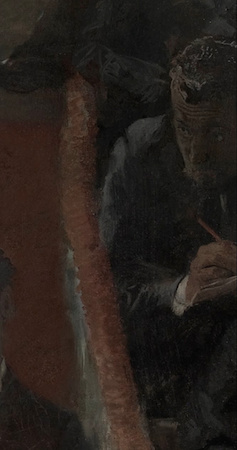
It is not solely a portrait of Dr. Gross; in addition to including the students and the assistants, Eakins inserted his own likeness among the audience – he’s the figure at the far right, sketching (one might consider Eakins the Alfred Hitchcock of nineteenth-century American painting). The core of the work is still Dr. Gross, however, as light and composition conspire to attract the eye to the esteemed lecturer.
Completed for the Centennial Exposition, Eakins intended The Gross Clinic as a statement of his artistic skill and as a way in which to affirm himself as a hero of Philadelphia. Though the work was rejected, the tactic was overall a success. While some critics lashed out against its gruesome subject matter, seemingly vulgar treatment, and inherent melodrama (note the near-swooning, hysterical woman in the left middle ground), viewers were nonetheless captivated by the work’s theatricality. Through his mastery of rendering convincing volume, individual representation, and psychological intensity, Eakins showcases his academic training and—in a style that has been dubbed “scientific realism”—reveals an uncompromising desire to portray honest details of form, depth, and proportion. He was obsessed with accuracy, and was known to project photographs onto canvases in order to laboriously trace figures though also to shift objects for a more harmoniously composed scene.
A Philadelphia painting
After The Gross Clinic’s exhibition at the U.S. Army Post Hospital—in a first-aid room meant to introduce viewers to modern medical paraphernalia—the Jefferson Medical College (where Eakins himself had taken anatomy classes) was given the painting by an alumni. A reproduction now hangs in the school, which sold the original in 2006. The work was considered so central to the history of Philadelphia, however, that the city’s two major art museums successfully rallied support to keep the tour de force in town with an ambitious fundraising effort that proved the work’s enduring value and underscored the fact that cultural artifacts can ignite complex debates. In closing, it should be noted that The Gross Clinic is not the only such medical scene Eakins produced. He later returned to the same popular formula to honor the surgeon David Hayes Agnew in a similarly composed (and equally controversial) work entitled The Agnew Clinic (1889), also on display at the Philadelphia Museum of Art.


